THOMASIAN ENGINEER
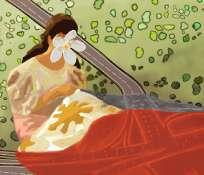

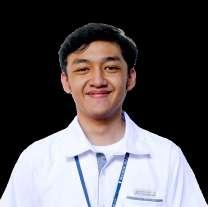
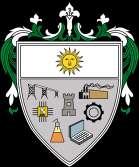
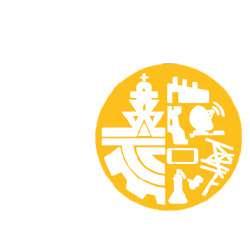
Candles, Fireworks Light up BACCALAUREATE

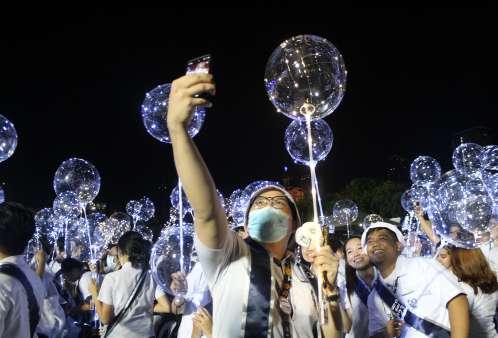
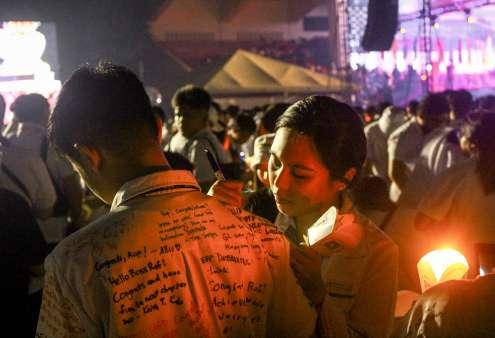










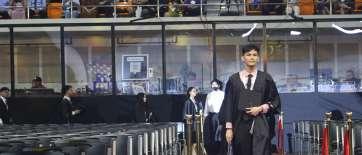

UST Faculty of Engineering graduates finally marked their college journey during the Solemn Investiture held last June 6, 2023, at the UST Quadricentennial Pavilion.
The processional of the 696 candidates for graduation opened the event and was followed by the invocation led by UST Faculty of Engineering (FoE) Regent, Rev. Fr. Roberto L. Luanzon, O.P., SThD, DL. The Address of Petition was delivered right after by John Heindrich Anog, BS Civil Engineering (CE) Magna Cum Laude and batch salutatorian.
“We will always remember that we should not feel pressure or envy in the success of others because we live in our own paths [...] because once and for all, we are Thomasian Engineers,” Anog shared.

Marking the near end of their college journey, 696 graduating engineering students took part in the Baccalaureate Mass 2023 last May 30, at the University of Santo Tomas (UST) Open Field and Grandstand.


The procession and presentation of all Faculties, Colleges, and Institutes of the University, with representatives raising their respective flags, formally started the event.
The University’s Rector, Very Rev. Fr. Richard G. Ang, O.P., presided over the Holy Eucharistic Celebration wherein he reminded the graduates to not just rehearse for their graduation but to get ready for the life ahead of them as well.
“Fulfill your destiny, be creative, be prolific in your chosen profession, and try to make a dent in the universe,” Fr. Ang remarked, imparting wisdom to the graduates in the homily.
After the mass, UST Central Student Council (USTCSC) outgoing President, Nathan Raphael Agustin, from the Faculty of Civil Law, delivered his graduation message for their batch.
Office for Student Affairs Director, Asst. Prof. Maria

Cecilia A. Tio Cuison, MEd, initiated the Conduct of Send Off Rights with Fr. Ang, and was followed by the Thomasian Mission Cross Blessing.
Joshua Raphael A. Tan and Jeremie Faye B. Umali, Loyalty Gold Awardees and graduating students from the Faculty of Medicine and Surgery, led the Recitation of the Thomasian Pledge.

Thereafter, Fr. Ang lit the main torch, which then lit the torches of the Deans and Regents of the respective Colleges, Faculties, and Institutes. This flame lit the candles of graduates, passing the light to each other during the traditional Ceremony of Light while singing the UST Hymn.
A 6-minute fireworks display, accompanied by the Voltes 5 theme song and KPop hits, namely, “How You Like That,” “Cupid,” “Flower,” “Pop,” and “Dynamite” lit the night sky.

To end the event, a total of 9,473 graduates from the University took their Ceremonial Recessional Walk at the Arch of the Centuries, a symbol of their exit, a callback to their Welcome Walk during their freshman year.
This was followed by the Address of Concession led by the presiding official, UST FoE former Dean and currently the Assistant to the Rector of UST Sta. Rosa Campus, Prof. Philippina A. Marcelo, Ph. D. After which, the imposition of hoods, led by the department chairs and president of each mother organization, on the candidates for their degrees took place. Engineering Dean, Prof. Angelo R. Dela Cruz, Ph.D., and Prof. Marcelo led the presentation of the candidates and the conferment, respectively.

Students with special awards were also recognized in the conferment of degrees. The Faculty produced a total of 206 Cum Laudes, 42 Magna Cum Laudes, and 1 Summa Cum Laude for this year’s graduating batch.
Cherline Anne Padilla Perez, BS Electronics Engineering (ECE) Magna Cum Laude, led the graduates in reciting the Thomasian Pledge on behalf of Jan Joshua Fetil, BSCE Magna Cum Laude and batch top 3.
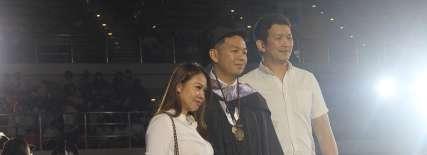


The fresh graduates were also inducted into the UST Engineering Alumni Association Inc. (UST-EAAI) by the Association’s Secretary, Engr. Bernardita C. Ronquillo. This was followed by the Address of Thanks by John Carlo Delos Santos, BS Mechanical Engineering (ME) Summa Cum Laude and batch valedictorian.
“Congrats everyone! I’m proud of you, graduates of batch 2023,” Delos Santos mentioned.

John Carlo Delos Santos, the recipient of the Rector’s Academic Award, led the Engineering graduates as its sole summa cum laude with a final General Weighted Average (GWA) of 1.149.

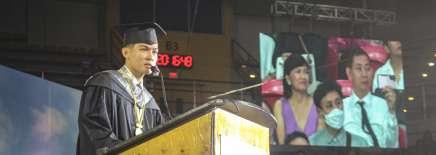




“In my case, I fought the good fight, I have finished the race and I kept the faith, Thank you very much” - Prof. Philipina A. Marcelo, PhD
Inspired by its donor, Thomasian Alumni and Jollibee Foods Corporation (JFC) Chairman and Founder Dr. Tony Tan Caktiong’s, ardent commitment to lifelong learning and education, the UST Tony-Tan Caktiong Innovation Center (USTTTIC) was inaugurated and blessed at UST Santa Rosa City, Laguna, last April 28, 2023.
A 15-year road map for the Center was given along with the three stages of the UST Santa Rosa’s long-term plans which include energy, information and communications, health and well-being, food security and safety, environmental sustainability, and material sciences. The aforementioned operating and sustainable plans were presented by Prof. Philipina Marcelo, PhD, Assistant to the Rector for UST Santa Rosa and former UST Faculty of Engineering (FoE) Dean.
“This Center will provide you with resources and support our stakeholders need to succeed” Very Rev Fr. Richard G. Ang O.P, Ph.D., UST’s Rector quoted in his message. Moreover, he emphasized the purpose of UST-TTIC which is to promote research and empower innovation by providing its stakeholders with necessary resources and support.
Tan Caktiong conveyed through his speech how pleased he was with the completion and opening of the innovation center. He also shared its significance to the UST community as well as the future development of our nation.
Dr. Tony Tan Caktiong earned his Bachelor’s degree in Chemical Engineering (ChE) and Doctorate in Business Administration from the University in 1975 and 2018, respectively.
Representatives of the Cebu Institute of Technology for the 4th Leadership & Management Perspectives in Higher Education (LAMP) Summit, held at the University of Santo Tomas (UST) Buenaventura Garcia Paredes Bldg., visited the UST Faculty of Engineering (FoE) last March 30, 2023.
The Institute was in the University from March 29 to 30 for the LAMP Summit and decided to benchmark the UST FoE and its laboratory facilities during their second day in the campus. Administrators and laboratory supervisors of UST FoE accompanied the Institute’s representatives throughout their visit to the Fr. Roque Ruaño Building.

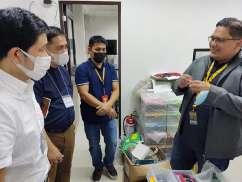
The two-day Summit, held from March 29 to 30, is a university-wide event and was organized by the Philippine Association of Colleges and Universities (PACU), in collaboration with the Committee on Institutional Quality Improvement (CIQI).
With the theme “One Size Fits All? Education Trajectories, Transitions, and Transformations,” this Summit aims to provide a space for school leaders to form strategic collaborations and discuss with each other their best practices regarding quality management in their respective institutions.
After more than a decade of service as Dean of the UST Faculty of Engineering, Prof. Philippina A. Marcelo, PhD, PECE turned over authority to now Dean Prof. Angelo R. dela Cruz, PhD, PECE on January 26, at the Engineering Conference Hall, Fr. Roque Ruaño O.P. Building and via Zoom meetings.

An opening prayer led by UST FoE’s Regent, Rev. Fr. Roberto L. Luanzon Jr., O.P., SThD, blessed the beginning of the faculty assembly. This was followed by the singing of the national anthem.
As Prof. Marcelo was called for a speech, she started saying how she believes that her days of giving speeches are over. For her, this was a bittersweet moment as she was able to welcome a new era or a new leader for the Faculty of Engineering.
Prof. Marcelo expressed her gratitude to everybody, from the reverends, support staff, the teaching staff, and also the alumni who have been supporting her from 2011 until her last day as the faculty’s dean. After meeting highly respected deans, she believes that leading a department is larger than life and that when you’re called to serve, then you abide
Prof. Marcelo also stated her apologies.
“I am sorry to those who were unhappy with some decisions I made, please be assured that every decision I made as a Dean of the Faculty of Engineering has been made to your best interest, everyone’s best interest,” she stated.
Although this decision was not very apparent during her first years, she was happy to see that everyone was patient to understand that her decisions were made with the faculty’s best interest in mind. And for her words as Dean, she expressed her love for the faculty. For Prof Marcelo, serving the faculty was unforgettable.
“When I retire, I will be sitting down, reading books and probably writing and those will be the years that I will cherish most,” Prof Marcelo expressed.
Prof. Marcelo was incredibly honored to have been given the chance to lead in the expansion and growth of UST after 400 years, together with the Father Rector, Dominicans, and other administrators. Prof. Marcelo also expressed her appreciation and affection to her family for their unwavering support and love.
To end her speech, she gave heartwarming advice from a book she used to read since day 1 of her leading the faculty to Dean dela Cruz and his board. She left him a verse from the bible, (Joshua 4:6-7) saying that “a leader’s attention belongs on what lies ahead. History is important because it provides a perspective to the future, but we don’t live in the past. There’s a difference between living in history and learning from it. Which do you do most often?”
Prof. Marcelo hopes that the same support given to her and


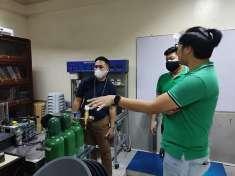

Tallying all the scores from the start of the Engineering Week, the ChE Department maintained their three-year streak as they emerged as this year’s overall champion at SPARK: The Engineering Broadway Night 2023 last February 18, 2023, at the UST Practice Gym.

After the opening remarks of the Faculty of Engineering Dean, Prof. Angelo R. dela Cruz, PhD, PECE, which marked the start of the Faculty showdown, Gab Campos, Joanne Almonte, and Danielle Eugenio were introduced as its judges.
First on the stage was the Industrial Engineering (IE) Department, which took inspiration from the musical, “Mamma Mia,” followed by the Electronics Engineering (ECE) Department’s performance of “Hairspray” and the Mechanical Engineering (ME) Department’s rendition of “The Sound of Music.”
After an intermission number by UST Ronins, the Civil Engineering (CE) Department decked the stage with their performance based on the musical “Into the Woods.” Finally, the Chemical Engineering (ChE) Department closed the showdown with their musical play “Wicked.”
Before announcing the winners for this year’s faculty showdown, the Silver Gear Awards took place where nominations and voting period commenced last February 11 to 13, 2023.
Awardees for the faculty category were recognized as recipients of the “Student’s Choice Award for Outstanding Academic Staff”: Asst. Prof. Dolores S.D. Cleofas, PhD, ASEAN Engr. (CE), Asst. Prof. Noel S. Sabarillo, MSc (ChE), Engr. Michael S. Matias, MEng (ECE), Engr. Mariz A. Chua (EE), Engr. Yoshiki B. Kurata, PhD, CIE, Assoc. ASEAN Engr (IE), and Engr. Ma. Francesca D. De Guzman, RMEE (ME).

her team will also be the same support that the faculty and staff will give to Dean dela Cruz and his team. She is grateful to God to turn over her position to somebody capable, committed, and somebody who loves the FoE and UST as well.
“In my case, I fought the good fight, I have finished the race and I kept the faith. Thank you very much,” Prof. Marcelo concluded.
Moreover, Rev. Fr. Luanzon awarded Prof. Marcelo a token of appreciation for her service to the Faculty.
Consequently, Dean dela Cruz officially commenced his era of leadership through a speech. For the newly designated Dean, even if it has been three semesters since he was appointed for the position, it is natural for him to doubt his ability and worth when given a blessing or opportunity to lead even with all the great people he has worked with.
“It is not the person who seeks the right position, but it is the position who searches for the right person,” Dean dela Cruz concluded.
However, despite his reservations, he guaranteed that each mistake he makes will be the best choice and not the right option because sometimes the right choice is not the best option to serve the common interest of the stakeholders and the people he is working with.

As a man who values family, Prof. dela Cruz also values his late mother’s words which say, “Mas mainam po na maging mabait kesa sa maging tama.”
To show his gratitude, he gave thanks to his family, friends, and everyone he has worked with in the past that led him to where he is now - a leader who will continuously aim to improve and develop the Faculty of Engineering.
To carry on with the assembly, FoE Faculty Secretary, Asst. Prof. Ma. Luisa T. Asilo, MEng, PECE, presented this semester’s dean, father regent, assistant dean, executive community members, laboratory supervisors and coordinates/support units, and newly hired staff. Shortly after, the enrollment statistics of the faculty was discussed.
Following this, Dean dela Cruz presented the expected awards and recognitions, faculty developments, research updates, accreditation visits, industry and alumni partnerships, a hybrid learning module, and proposed changes to be conducted this 2023 and to the following years of UST.
Assistant Dean Asst. Prof. Tiangco also discussed important reminders regarding academic staff and the students, which include term guides, attendance checking of academic staff, course deliveries, pre-requisite courses, uniforms, absences, assessments, mimeographing services, and encoding or completion of grades.
To end the assembly, a question and answer portion was provided for the onsite and online audiences of the meeting.
“I think bawat professor […] faculty sa engineering deserves this award,” Asst. Prof. Sabarillo stated as he received his award.
Afterward, awardees for the student category were acknowledged as well: Allyssa Joy Idio (Fr. Roque Ruaño Leadership Award), Steven Mathew Solis (St. Cecilia Award), Industrial Engineering Circle (St. Martin De Porres Community Development Award), Operations Research Society of the PhilippinesUST Branch (St. Aloysius Gonzaga Award), and Martin Alfonso Bonilla (St. Sebastian Award).
For the contest winners, Steven Matthew Solis for Amor: Ang Liyag ng Isang Tomasinong Inhinyero, a vlog fest, and Jeremy Edera for Sinag - Ang Sentimyentong Pagbabalik Sa Ruaño, a photo contest.

The faculty’s student band “Illumina” then covered Eraserheads’ “Huling El Bimbo” and Mayonaisse’s “Jopay”.
Moments after, the IE department was hailed the winner of the Faculty Showdown as well as Best Poster. They were followed by the ChE and CE Departments, respectively. The ECE department, on the other hand, won the Best AVP Award.
Engineering Student Council (ESC) adviser, Assoc. Prof. Carlos Ignacio Jr. P. Lugay, PhD, PIE, ASEAN Engr., then gave his closing remarks, kicked off the guest bands’ concert, which featured Sunkissed Lola and Orange and Lemons.
Sunkissed Lola opened their set with their latest single, “Makalimutan Ka” and ended with one of their hits, “Pasilyo.” Orange and Lemons took the stage next and performed their most memorable hits, a track from their newest album, and a jamming session with the IE Department of Abba’s “Dancing Queen”.
WRITTEN BY : Nicole Nadela WRITTEN BY : Carl Tristan Gile PHOTOS BY : Laurence Gabriel Arellano and, Ma. Victoria A. Lopez WRITTEN BY : Jose Miguel Ballecer and, Mary Andrew Dalogdog PHOTOS COURTESY OF UST Faculty of Engineering Dean’s OfficeThe UST Faculty of Engineering (FoE) celebrated Atty. Engr. Josefin S. de Alban Jr.’s 44 years of service to the University through a Special Lecture entitled “Lecciones de Vida,” on June 10, 2023, at the Frassati Auditorium, UST Blessed Pier Giorgio Frassati, O.P., Building.
An opening prayer delivered by UST Pax Romana - Engineering President, Larie Linsangan, commenced the program. This was followed by the special messages of UST FoE Dean, Prof. Angelo R. dela Cruz, PhD, PECE, and UST Civil Engineering Department (CE) Department Chair, Engr. Rajiv Eldon E. Abdullah, MENG.
“A true servant leader does not restrict his constituents from growing. To Dean de Alban, taos-puso po ang pagpapasalamat namin,” Dean dela Cruz mentioned.
“Sir de Alban never failed to assure me, along with the other pillars of the department, that they always have my back













[...] Sir de Alban, we salute you,” Engr. Abdullah shared.
Moreover, UST One Voice Engineering Chorale decked the event with their rendition of songs that reminisced Atty. Engr. de Alban’s fruitful years as a Thomasian Educator. Atty. Engr. de Alban proceeded with his lecture opened by a discussion on Intellectual Property Rights. Furthermore, he shared some of his significant memories and experiences with which realizations and important life lessons can be drawn from. Afterward, his brothers and former students provided their insights on the discussion and shared some of their treasured memories with him.
A photo opportunity with his family, friends, colleagues, and students occurred after.
Atty. Engr. de Alban is set to retire this year after serving the University for 44 years since 1979. He was a former UST FoE Dean and UST CE Department Chair.


Fourteen faculty members from the UST Faculty of Engineering (FoE) have been recognized for their exemplary performance and contributions in the various aspects of the engineering field from March to June 2023.
In recognition of their research productivity in their field of specialization, 11 academic researchers from UST FoE were recognized at the Research Recognition Day last March 9, 2023, at the Grand Ballroom, 2/F Buenaventura Garcia Paredes, OP Building (BGPOP).
The academic researchers of the faculty were declared to be recipients of the Gold and Silver Series Awards for the Academic Years 2016-2018, 2018-2020, and 2020-2022.
The awardees who received the Plaque of Recognition were as follows: Asst. Prof. Beatriz A. Belmonte, Ph.D. from the UST Research Center for the Natural and Applied Sciences (RCNAS), Prof. Michael Francis D. Benjamin, Ph.D. (RCNAS), Asst. Prof. Jojo F. Blanza, Ph.D. (RCNAS), Prof. Angelo R. Dela Cruz, Ph.D., PECE (RCNAS), Prof. Maria Natalia R. Dimaano, Ph.D. (RCNAS), Engr. Lola Domnina B. Pestaño, Ph.D. (RCNAS), Engr. Edison A. Roxas (RCNAS), Engr. Kanny Krizzy D. Serrano (RCNAS), Engr. Angelito
A. Silverio, Ph.D. (RCNAS), Asst. Prof. Cristina E. Tiangco, Ph.D. (RCNAS), and Engr. Lyn Marie Z. De Juan-Corpuz, Ph.D. from the UST Research Center for Culture, Arts, and Humanities (RCCAH).
The new set of Thomasian leaders was announced to the student body during the “Proklamasyon 2023” held at the UST Seminary Gym and streamed via UST-TOMCAT’s official Facebook page last April 1.
Prior to the proclamation, outgoing members of the executive board of the local colleges and faculty were called to the stage and asked questions about their journey and experiences as leaders of their respective faculties and colleges.

“The Faculty of Engineering also advocates for not only yung writing equations to solve lang but then also real-life problems and innovations para makatulong sa community natin,” Pauline Zian A. Suyat, Internal Vice President and Acting President of the UST Engineering Student Council (ESC) shared when asked how their projects reflect the Faculty itself.
Suyat also stated that she wishes the next ESC Executive Board to continue an advocacy-driven service that extends beyond their college journey for the Faculty.
“It’s important din na huwag natin kalimutan kung para kanino ba talaga bakit tayo nasa posisyon na ito [...] this is for the students,” she added.
After which, the new set of central and local college student council members were announced. Yves Caballes, UST Engineering Commission on Elections (COMELEC) Chairperson, led the proclamation of the victors in the recently concluded ESC Elections.
Asst. Prof. Belmonte also received both the Silver Award (AY. 2016-2018) and Gold Award (AY 2018 - 2022), Prof. Benjamin bagged Gold (AY 2016-2022), Asst. Prof. Blanza obtained Gold (AY 2018-2022), Prof. Dela Cruz received Gold (AY 2016-2020), Prof. Dimaano bagged Silver (AY 2016-2020), Engr. Pestaño obtained Silver (AY 2016-2020), Engr. Roxas received Gold (AY 2018-2020), Engr. Serrano received Silver (AY 2016-2020), Engr. Silvero obtained Gold (AY 2016-2022), Asst. Prof. Tiangco bagged both Silver (AY 2016-2018 & AY 2020-2022) and Gold (AY 2018-2020), and Engr. De Juan-Corpuz received Silver (AY 2018-2020).
Furthermore, two faculty members from the UST Industrial Engineering (IE) Department received recognitions during the 13th International Conference on Industrial Engineering and Operations Management hosted by De La Salle University - Manila last March 6 to 9, 2023 in Hilton, Manila.
Prof. Marilyn C. Mabini, PhD, PIE, ASEAN Engr. received the IEOM Women in Industry and Academia (WIAA) Award while Assoc. Prof. Joehanna K. Ngo, PhD, PIE, ASEAN Engr. garnered the IEOM Society Outstanding Service Award.


Moreover, UST Civil Engineering (CE) Department faculty member, Engr. Mark Elson C. Lucio, MSCE, was hailed as the new President of the Association of Structural Engineers of the Philippines, Inc’s (ASEP) Officers and Board of Directors in June 2023.




With the end of another academic year, the term of the current Engineering Student Council (ESC) comes to a close. In an interview done with the publication, the former ESC officers shared their opinions on their performance, purpose, ending their term as officers in their current position, and their advice to the new set of officers.
“I think what contributed to the success of our academic year was the people around us – you can’t be an individual, individualistic, you should be a team player,” Alyssa Laraine Cunanan, former ESC secretary, shared when asked how the council dealt with the challenges of being a student-leader.
During their term as the set of officers, though shortened after having only officially taken their oath last November 29, 2022, the former council viewed Engineering Night 2023 as one of the most memorable events for them.
Meanwhile, when asked what changes they saw in their new and old self, “I learned how to reach out to people. Back then, I always thought that doing everything by myself was good, but when you’re in this position, mas kailangan ka sa administrative work kaysa sa groundwork,” former PRO Claudelle Fajardo shared, highlighting the importance of being adaptable, decisive, and delegating tasks as the main realizations or growth she had in her journey.
“Council tayo to lead them. Council tayo na finoform din natin yung students, hindi lang para maging mabuting estudyante, but then para sila maging mabuting tao, even outside the campus,” Pauline Zian Suyat shared.
Assistant Secretary and Community Development Officer-in-Charge Mauricia Sophia Villanueva also shared that she wishes that TURU, a Community Development Project currently in its 2nd year, be continued by the next set of officers. Additionally, Laraine Cunanan wished for the continuity of the newsletter, while former Assistant Treasurer Lourd Bañaga, mentioned food fest, and job fair.
Meanwhile, they saw time management, teamwork, people management, and improved social skills as a few of the lessons they won’t gain elsewhere.
All the former officers shared the same sentiments—to become pillars and leaders for the student body—making sure their voices were heard when asked what pushed them to apply and become part of the ESC executive board.
IVP and Acting President Pauline Suyat shared that as their term ends, she wishes for the student body to continue to be active and engaged students. Alyssa Cunanan, ESC Secretary, advised, “Keep on speaking because you will be heard no matter what […] at the end of the day, those ripples will create bigger ripples.”
Additionally, Mauricia Villanueva wishes that the student body view the council as someone the students can run to, sharing, “Don’t be afraid to ask for help from anyone. Andito rin ang student council na tulungan ang student body. Struggles in life are very normal, and the only way to resolve these is to ask for help from anyone, para ‘di kayo nahihirapan and sinosolo ang mga problems.”

“Remember that you are the voices of the UST Engineering
Marc Vincent U. Distor is set to lead the Executive Board as the new ESC President with a total of 2,385 votes. Joining him as the new set of Executive Board Members are Desiree Louise I. Rivera as Internal Vice President (2529 votes), Mikaella Jilliane A. De Guzman as External Vice President (2442 votes), Jhan Rheginald B. Supan as Assistant Secretary (2,361 votes), Isaiah Jacob B. Samson as Treasurer (2,425 votes), and Jamie Angelica B. De Mesa (2,414 votes).
Joemille Brent R. Galera (1,417 votes) and Charlette Jane V. Deocadiz (1,142 votes) also emerged as the top choice for Auditor and Public Relations Officer, respectively. Only the position of Secretary was left vacant for the upcoming ESC Executive Board. A 69.63-percent voter turnout was recorded by the Engineering COMELEC for the ESC Executive Board Elections 2023. Additionally, the new set of central student council members is as follows: Ierathel Tabuno from the Faculty of Arts and Letters as President, Aiah Karrylle Jacinto from the College of Commerce and Business Administration as Vice-President, John Harold Peralta from the Faculty of Medicine and Surgery as Secretary, Rafael Luis Pesueña from the College of Commerce and Business Administration as Treasurer, James Arrenkiel Ceñido from the College of Business Administration as Auditor, and Maxine Javier from the College of Arts and Design as Public Relations Officer.

community– do not fail them and never discriminate. For your sake, always keep your personal life, personal. Even though you are leaders of the community, you are still entitled to your own personality,” Lourd Bañaga shared as his message to the next set of officers.
The former officers also shared their good wishes for the platforms of the next set of officers as Alyssa Cunanan stated, “Hopefully, they would be able to do their initiatives, their projects. … I do hope that they will be able to pursue the changes that they want and also … that they don’t forget why they’re here– it’s their platforms and promises. … At the end of the day, what you said to the community, always hold on to that.”
In a word, they wanted the student body to view its upcoming executive board members as “Takbuhan,” “Home,” “Masasandalan,” “Goal-oriented,” and “Bridge.”
The ESC officers for the academic year 2022- 2023 consisted of Pauline Zian Suyat (Internal Vice President and Acting President), Alyssa Laraine Cunanan (Secretary), Sophia Mauricia Villanueva (Assistant Secretary), Joemille Brent Galera (Treasurer), Lourd Albert Bañaga (Assistant Treasurer), and Claudelle Fajardo (Public Relations Officer).
Currently, the former set of officers, with the exception of the former Treasurer Brent Galera, who was proclaimed as Auditor of the ESC Executive Board 2023-2024, have graduated. When asked about their plans after their term as ESC officers, all shared that they wish to improve themselves further and become engineers in their rights while still being alums with the heart to serve.
 PHOTO BY : Alex Tacderas
PHOTOS BY : Sebastian Gauce
WRITTEN BY : Aryzza Aperocho, Jose Miguel Ballecer, and Marc Ivan Dilla
PHOTO BY : Alex Tacderas
PHOTOS BY : Sebastian Gauce
WRITTEN BY : Aryzza Aperocho, Jose Miguel Ballecer, and Marc Ivan Dilla


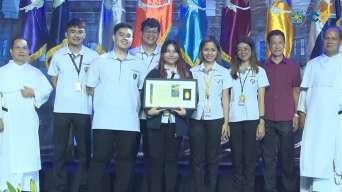




Students and organizations from the Faculty of Engineering (FoE) were recognized for their academic and non-academic feats in Student Awards 2023 last May 26 at the UST Quadricentennial Pavilion.
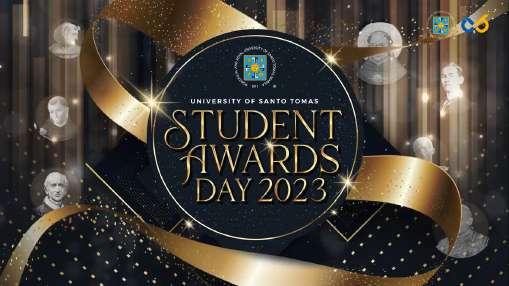
John Carlo N. Delos Santos, Mechanical Engineering (ME) student, was conferred a Rector’s Academic Award for his outstanding academic performance garnering a GWA of 1.149.

Jaminah S. Muarip, Chemical Engineering (ChE) student, Training director of Becarios de Santo Tomas, and University Scholars Association of the Philippines (USAP) President for External Affairs for the Academic Year 2022-2023, was bestowed with a Quezon Award for her leadership roles in USAP.

The University also awarded the UST CISCO Networking Academy Gateway and the UST Industrial Engineering Circle (UST-IEC) with a Pope Leo XIII Award for their active participation and engagement in community development.
Meanwhile, Pope John Paul II Awards were received by Justin Mark S. Agno from the IE Department for his achievements in Taekwondo and Joseph Den Amores from the Electronics Engineering (ECE) Department for his feats in Fencing. Ernest John Obiena, an ECE student, was also recognized during the event for his accomplishments in Pole Vault sports.
Furthermore, groups of Industrial Engineering (IE) students bagged the St. Albert Magnus Award for their undergraduate research work, namely: John Depp C. Adorna, Cheska Nicole A. Cuevas, Eunice Jessica M. Fernandez, and Zaver JB S. Pascual; Ranice Ang, John Carl Angeles, Bianca Bornilla, and Justine Lian Fabia; and Aubrey A. Angeles, Aprile C. Ilano, Darwyn P. Ong, and Vince B. Reoyan; Guia Lorraine R. Ong, Johan Mikaela A. Simon, Jonah Marie T. Chan, and Warren Miguel G. Benito.



The Chemical Engineering (ChE) Team was proclaimed as back-to-back champions of the 42nd General Information Quiz Contest (GIQC) held at the Physics Laboratory of the Fr. Roque Ruaño Building on February 16, 2023.
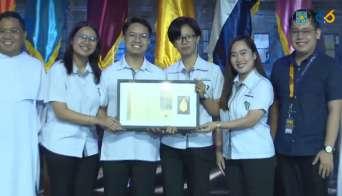
The GIQC, organized and hosted by the Thomasian Engineer (TE), is an annual quiz bee that tests participants’ knowledge of the University of Santo Tomas (UST) and the UST FoE history, Philippine history, current events, general knowledge, algebra, calculus, plane trigonometry, plane geometry, solid geometry, analytic geometry, chemistry, and physics.
Engr. Ma. Madecheen S. Pangaliman, MSc. commenced the event with her opening remarks, in which she emphasized that the contest serves as an opportunity to learn something new and expand their understanding of different topics.
“Through this competition, we hope to create a healthy and friendly environment that encourages learning and encourages the exchange of knowledge,” she remarked.

In both editions of the competition, the questions, which were a total of 48 for the student-level category and 24 for the faculty-level category, were spread evenly across three rounds with varying difficulties: the easy, average, and difficult rounds, which merited three (3), five (5), and nine (9) points, respectively, when answered correctly within the set time limit for the category—30 seconds for the easy round, 1 minute for the average round, and 3
minutes for the difficult round.
Reminiscent of the turn of events during last year’s GIQC, the ChE and Electronics Engineering (ECE) departments both topped the average round with 32 points, beating the Civil Engineering (CE) team by 5 points, Electrical Engineering (EE) team by 10 points, Mechanical Engineering (ME) team by 8 points, and Industrial Engineering (IE) team by 21 points.
The ChE team then edged out the competition towards the end of the contest during the difficult round by amassing a total of 45 points versus the EE team’s 36 points, the CE, ECE, and ME teams’ 27 points, and the IE team’s 18 points.
By the end of the student edition, the ChE team, composed of Joshua Ronard De Castro, Franc Lorenz Cacal, Darren Cerado, and Justin Robert Tolentino, garnered 77 points and were hailed as champions of the GIQC. The ECE team, comprising Sophia Gabrielle Suarez, Kiel Ethan Lanzanas, John Earl Patrick Sandoval, and Leighla Louisse Sto. Tomas came in second place with a total of 59 points. At the last spot on the podium was the EE team, composed of Justine Queenie Bacani, Aaron Emmanuel Panglima, Justine Kylie Zaguirre, and Ma. Cielo Galuno, placing only a point behind the ECE team.
Subsequently, the competition proceeded with the faculty edition, where the mechanics were the same, but the participants

would be competing without available lifelines, unlike in the student edition.
The ECE team dominated the easy round by being the sole team to garner 18 points, while the team also remained at the top spot during the average round, scoring 20 points alongside the ChE team. The ChE team fought for the top spot during the difficult round where they earned 54 points—9 points in the lead of the ECE team during the said round.
Garnering 83 points after the difficult round, the ChE team and the ECE team had a clash of quick wits during the tiebreaker, in which the ECE team answered the question correctly first.
The faculty edition of the GIQC ended with the ECE team, comprising Engr. Harold Alexis A. Lao, Engr. Jehiel D. Santos, M.Phil, and Engr. Michael S. Matias, MEng, placed at the top spot with a total of 84 points. Following them were Asst. Prof. Noel S. Sabarillo, MSc, Asst. Prof. Basil James S. Santos, MS, and Engr. Divine Angela G. Sumalinog, Ph.D. of the ChE team, garnered a total of 83 points. Behind the ChE team was the CE team, composed of Engr. Paul Marion J. Demapelis, MSCE, Engr. Harf J. Miranda, MPE, and Instructor Stacey Henry Nuqui, who placed third with 46 points.
After the faculty-level category tie-breaker round, the top three winners from both the student- and faculty-level categories were recognized.
WRITTEN BY : Lance Campano PHOTOS BY : Bea Galvez WRITTEN BY : Marc Ivan Dilla and Aryzza Antonette Aperocho PHOTOS BY : Ray Baltazar AlunenENGINEERING IS PERCEIVED AS THE APPLICATION OF VARIOUS SCIENCES FOR THE FULFILLMENT OF AN OPTIMAL AND SUSTAINABLE CONVERSION OF AVAILABLE RESOURCES FOR THE CONVENIENT USE OF THE PRESENT AND THE BETTERMENT OF THE FUTURE (ENCYCLOPEDIA BRITANNICA, N.D.)
Moreover, we can say that engineering has been and will always have a significant influence in the total development of a country, whether in the field of infrastructure and proper housing, healthcare, agribusiness management, technopreneurship, public policies, sustainability, risk assessment and mitigation, and other economic and social responsibilities - and thus, should be treated as a noteworthy topic to discuss during public addresses such as the annual State of the Nation Address.
MARCOS AND HIS PREVIOUS [AND PRESENT]
PLANS FOR THE ‘COUNTRY’S BIGGEST PROBLEM’
President Marcos started his address by recapitulating what seems as ‘the country’s biggest problem’ last year – inflation. Due to the pandemic and other external factors affecting the downhill trend of our economy, the administration took more steps for its recovery against inflation. Here goes the National Economic and Development Authority publishing the Philippine Development Plan for 2023 to 2028, as fulfillment by the President’s task on his first SONA, with social and economic transformation as its primary focus. Consequently, the Philippines has been reported to record a 7.6% year-on-year Gross Domestic Product (GDP) growth by the end of 2022, which was recorded as one of the fastest increases in Philippine history. The local economic movement has increased by this rate through either the procurement of more goods and services for government projects or through higher volumes of exports and imports. Even so, a drastically increasing GDP growth might damage the currency’s value since it tends to contribute to higher inflation, most especially if the government has been focusing on spending more on superfluous public expenditures and incurring more debts. The government should further consider not rushing economic development if it cannot be supported financially and geographically to its fullest. This might be also the reason why this recorded progress cannot be fully felt by every constituent. A national achievement shall not only favor the high, but also enjoyed and celebrated by the masses. Always.
Now you may wonder, how does engineering support the economy and combat inflation? Well, digital transformation - as a long-term and sustainable solution for the alleviation of inflation, automation and precision of production, and for the minimization of wasted traditional resources. Civil engineers use cloud computing for virtual heavy design simulations, such as national infrastructure. Mechanical engineers use high-performance computing for expanded and automated data management. Electrical engineers, as front lines of daily technology, use embedded and
other modern systems to improve the performance of our electrical needs. Electronic engineers use digital techniques in improving transmission efficiency for better future smart cities and eco-zones. Chemical engineering uses the Internet of Things to automate the monitoring of performance metric trends. Industrial engineers are known to improve processes for less wasteful yet quality-flowing services through data-driven studies. The optimization of resources’ allocation, including the finances, is indeed a large factor in the success of a project for it tells the level of responsibility and sharp-wittedness of the project heads. This idea can be supported by the report that our digital economy has contributed 9.4%, equivalent to 2.08 trillion pesos, to the overall GDP of the Philippines in 2022 (Philippine Statistics Authority, 2023). It is also recognized on the address that growing volume of BPO companies and the stable remittance flow are the largest contributors in the GDP growth, which are known to utilize digital resources to their fullest potential. In this technology-advancing age, we must adapt with the good changes entailed to it. And we, engineers, are in the position for these ‘good changes’.
For years, the public must have been quite weary of hearing the government’s plans in creating better transport systems, which eventually turns out as added non-inclusive things undeserving for the people. It is fairly interesting to know from the President’s address that their plans of [re]engineering the Philippines does not limit with the expansion of national infrastructure. Food security was mentioned to remain as one of the top priorities for the next few years as well, which is known to be one of the top concerns of engineers. Moreover, we shall always bear in mind that food security does not end with short-lived solutions, particularly ayudas during emergencies or calamities. Food security is more about the long-term capacity of a country to provide clean, cheap and accessible food and water to the needy anytime and anywhere. Kadiwa market prices are relatively cheaper than other retail stores, yet it still does not give justice to the selling prices of these commodities from the farmers and fishermen themselves. It’s quite ironic to hear the assurance that the government does their part in searching and charging hoarders, smugglers and unjustly middle men when the mass has not felt any relief in their succeeding purchases as the result of this act. These front line workers should have their very own avenue for selling their crops so they can fully enjoy the fruits of their labor, and at the same time, the people get to enjoy legitimate cheaper market prices. Aside from streamlining the selling process of commodities, this can be started by the plans of developing rural infrastructure in the country, which the President has further mentioned. The President also hinted at their aim of having a more responsible and sustainable food production in order to address the roots of the issues in food security. However, amendments in fisheries and cooperative codes are the sole concrete plans supporting this vision. Two-decade old Republic Acts does not need any more of these adjustments, yet it is in a call for better comprehension
and implementation. The sectors should consider studying better solutions in engineering food security and sustainability that could still benefit in the distant future, such as the public support for food engineers, automation of storage and post-production processes to reduce rejected commodities, organization of official local food drives, safe bioengineering innovations and the likes.
Despite the administrative efforts of providing millions of rice, corn, and vegetable seeds over the past year, and even with the offer of cheaper locally made biofertilizer, the Philippines has still incurred a 1.0% decrement in the production value of crops and 6.6% decrement for fisheries, as reference to 2018 prices (Philippine Statistics Authority, 2023). It is either the volumes of production or the farmgate prices for these commodities have relatively decreased in comparison to the said reference period.
Furthermore, the President was on spot as he mentioned that water security is as of an equal importance as food security. And with that, he emphasized that it should have a special focus in making it a “cohesive, centralized, and systematic” one. Yet the question still goes the same: How in particular? Aside from the plan of establishing a new water resources management department and the immediate allocation of 14.6 billion pesos for its projects without presenting cost-benefit analyses, what are the specific steps in fulfilling the centralization of water treatment? Is this an optimal movement for the archipelagic state of the country? We keep our heads high on this matter to the upcoming water department. And we hope that the people leading this office are the worthy ones – people from the engineering field.
President Marcos has emphasized infrastructure as one of the key elements in a country’s economic growth. For the past administrations, urban infrastructure, particularly the expansion of the major transport roads, has been a top priority. This goes the same with Marcos’s presidential term. His enthusiasm to continue the ‘legacy’ of the Build, Build, Build Program by the Duterte administration says it all up to now - hence the creation of its superseding program, Build Better More.
Another highlight of the address is the promise of constructing a 1,200-kilometer Luzon Spine expressway program, which aims to connect Ilocos and Bicol with an approximate 55% travel time reduction. Moreover, there are other mentioned network links to be established as well, hopefully, to easily travel to two provinces separated by major bodies of water.
In line with the advocacy of strengthening food security and sustainability in the country, the government has presented some steps to support it. First on the list, the geo-agri maps of farm-tomarket roads were improved to conveniently easily connect the farmers to the markets. 600 kilometers of farm-to-market roads were also added over the past period.
Eight new power-generating facilities were reportedly added to the land, which helped in adding 1,774 megawatts of energy. Total electrification by the end of 2028 is also what is to be aimed by the government, since the previous milestone it has taken has enabled power generation for half a million households nationwide.
Thousands of renewable energy projects are also to be implemented in the whole country. Moreover, the government should consider its advantages, especially its financial aspect. It is quite common knowledge that investing in various renewable energy resources entails expensive storage costs. This might hurt the budgeting strategies of the consumers, despite its strength in reducing carbon emissions. The government should still consider other options as better commercially-viable alternatives, if ever these renewable resources are not around the clock nor unable to cater the massive demand. This can be successfully obtained through the application of different operations management techniques, mostly used by industrial and chemical engineers.
FILIPINOVATION
A term used by the President during the address – “a state of innovation interconnected with entrepreneurship” that shall be adapted by the country, together with the respective development of science and research. The plans for the industry remain the same, which revolves with scholarships and the “Balik-Scientist” program.
The Bangko Sentral ng Pilipinas’ call for a cashless society has been mentioned a couple of times, backed with various statistical information regarding its shares to the economy, however again, there are no concrete plans for its future enhancement. The attempt of planning the digitalization of the National ID system has been laid, yet we know that the production and delivery of the identification cards are still experiencing bottlenecks. A problem cannot be truly solved with a band-aid solution on hand.
Yet on the brighter side, the Philippines might have gone a long way as it successfully surpassed its previous rankings in the fixed internet speed (rank 46th out of 180) and mobile internet speed (rank 84th out of 180). The next call for this milestone is the inclusivity of fast and stable internet services in the rural and disadvantaged areas of the country.
As Marcos explicitly states “Walang mamamayang Pilipino ang maiiwanan”, I can’t help but wonder: If inclusive progress is really happening, then how is it not felt by all? How come that the field of science, engineering and research is still being hushed up to now? Adulthood has led us to dream that the young become professionals someday, like engineers and scientists. Yet when the actual work takes place, it seems like that aspiration and the manifested dealing are inharmonious. Regardless of which department one does belong to, engineers are definitely vital in the role of scientific investigation and problem solving with the application of world-friendly traditional and to-come revolutionary, and most especially, digital resources in an area.
It is now that we look as the right time to witness and listen as to what President Ferdinand R. Marcos, Jr. visions for the progress of engineering in this country. Will he be able to redeem his promises for the country? Or maybe, just maybe, will he go back to his ‘golden’ word? Only time and wisdom could tell.
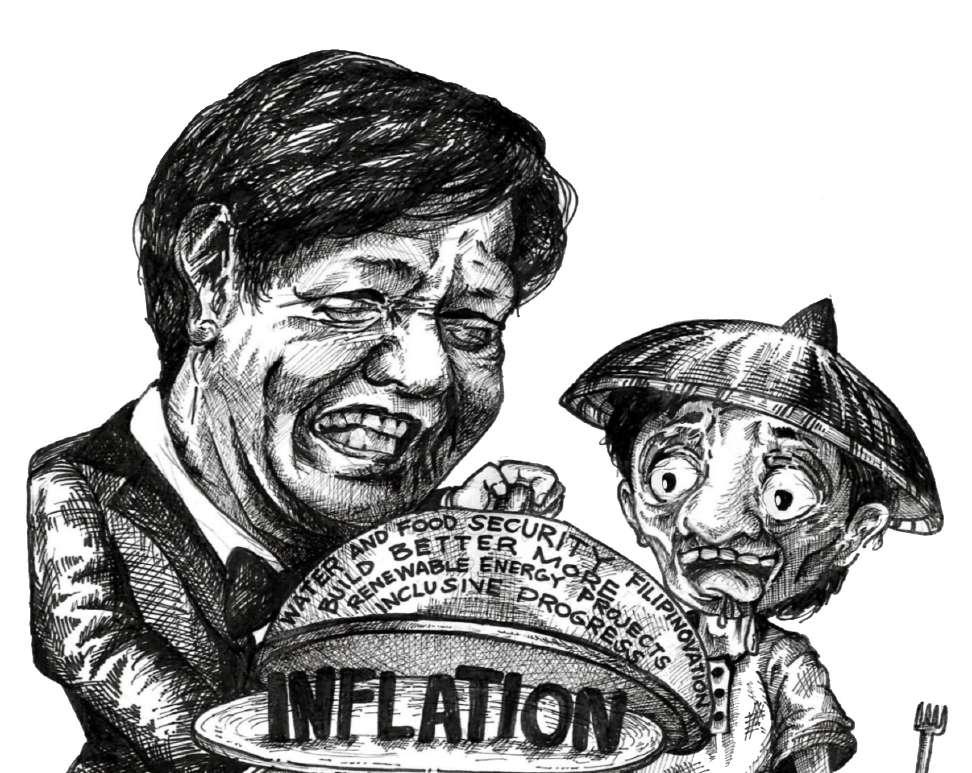


Scorching heat, melting icebergs, and roaring storms are only a few of the effects of a significant global phenomenon—climate change. The heat in our country cannot be blamed on its geographical location alone as much of these effects are owed to climate change. It is clear that the climate crisis that came to be is a repercussion of man’s own doing, so it is we who reap the consequences. Greenhouse gases, which deplete the ozone layer, are usually produced from manufacturing, transportation, and power generation, which are daily human activities. Though such activities are crucial, there unequivocally are better, more sustainable, and more eco-friendly alternatives despite some manageable drawbacks, yet why don’t people resort to these instead?
The problem is that some people wanting to mitigate the effects of climate change resort to band-aid solutions instead of delving into the root cause of the problem—the education crisis, which is an evident problem in the Philippines. The climate crisis the world is facing currently is due to the ignorance of people on its underlying effects, so to call them to act on it entails the necessary education on this complex interdisciplinary issue. Despite the excuses people hurl on acting on this global crisis, it is essential to elucidate the people on reasons why education is the best action and an essential solution to the said crisis.
First, climate change education is crucial to effectively spur consistent action and engagement. The action comes after awareness and knowledge. Before compelling people to act on the crisis, they need to know its impact on them personally, and not just digest pure concepts that would get discarded in a flicker. This is what schools in the country commonly get wrong—they condense technical terms and concepts into students’ minds and expect them to do their part in the climate crisis. Students from the Fortune High School, Marikina City said that they were not content with the climate change lessons they had in school, noting that they wanted to know more about the subject. Memorizing terms and key concepts is not a way to learn about the problem—we need to dig deeper into the problem because climate change is not an issue that can be solved with superficial knowledge and actions. Actions on climate change should also be taught practically. Receiving hands-on lessons and activities instills learning in people. According to Riyad et al. (2020), practical education imposes a deeper impact on learning, translates ideas into usage, and develops skills. Therefore, to effectively test students’ knowledge on the matter, practical activities are needed as well aside from purely written ones, as the latter would only test theoretical knowledge instead of practical.
Another common fault is to guilt-trip people into thinking that they are at fault in this climate crisis. While it is true that humans and their daily unbridled actions have engendered the issue, it is not something to be dealt with alone, but it should also not just be other people’s burden. Climate change is a complex social, political, and environmental issue that necessitates systemic action. While individual persons should still do their part in solving this crisis, it should not kindle a thought that we are alone in solving it. Despite progress, amassed individual efforts are still overshadowed by the amount of greenhouse gases generated by large industries and developed countries. According to Kurzgesagt (2021), fully eliminating an individual’s carbon dioxide emissions for 70 years is only equivalent to the global energy sector conserving their emissions for one second. This implies that systemic action should be the emphasis to effectuate substantial progress in acting against climate change.
Once people are educated on the essential concepts, and most importantly, the impact and effects of climate change on them, this compels them to act. And, to act consistently, people can tap into behavioral science. Based on a study by the University of California in
2017, consumers were encouraged to conserve energy through subtle social pressure. Thus, incentivizing individual actions helps people keep up with their work. And while doing their part individually, once people are adequately educated, they will be driven to move the people at the levers to initiate systemic change. Becoming aware of and understanding the problem including viable solutions will extend people’s voices to prompt politicians into creating and implementing the policies necessary to bring the change the world needs.
Second, climate change education is necessary to allow people to make informed actions and decisions. Even as people have knowledge of the causes, effects, and other essential concepts associated with climate change and it compels them to act, they need to know how they can act. The problem is that what people commonly know are superficial solutions, but they need a deeper understanding of how exactly they can do their part while making the biggest impact they can. For example, if there was a school or community competition held to choose the best outfit made from recyclable materials, isn’t there a large tendency for competitors to use entirely new and unused materials instead? This, therefore, beats the purpose of recycling waste. It makes new ones, instead of recycling the actual waste that is still polluting landfills, water sources, and the environment as a whole. Leah Cortez, a graduate school professor at the Philippine Normal University, said that even the slightest inaccuracy in the message of recycling programs may cause students to create more trash instead of recycling. Therefore, in the example, initiating recycling competitions is not wrong, but it can be made right with the proper rules on strictly using actual waste. And this can be corrected if people become sufficiently educated on the impacts of their actions, prompting them to take the best possible action they can to help save the environment, and especially, themselves.
Third, climate change education is needed to fight misinformation and disinformation about climate change. Especially at this time when the use of social media is prominent, the dissemination of false news is easier than ever. A 2022 Pulse Asia report has revealed that 90% of the adult population in the country has encountered fake political news through different forms of media. We have learned enough from the pandemic—false news, false medicine and treatments, and even false political information. If nothing is done to solve this situation, more false news will spread about climate change—and there already is. Scrolling through social media about the topic of climate change will not take you long to see people who still believe the climate emergency is propaganda—or that there is no emergency or issue to worry about at all. Knowing that climate change is a real-world issue, it is worrisome to read views such as these. Thus, prompt action should be taken against it by identifying misconceptions and correcting them on various media, especially on social media. Otherwise, the issue is going to take a toll on everyone before they even realize it.
Fourth, climate change education is essential to commence a chain reaction for systemic action. Acting on one’s own part is barely enough to solve the climate crisis; what we need at this moment is systemic action. Aside from the common individual actions of recycling and planting, once numerous people have gained adequate knowledge and understanding of the underlying problem and effective solutions, they will be compelled to share this knowledge as part of the actions they know they can take against the problem. for the future. Education goes more than just teaching us; it propels us to act. Knowing about the essential concepts is the first step, and when people understand the problem them to know more about

 WRITTEN BY: JOSE MIGUEL BALLECER
WRITTEN BY: JOSE MIGUEL BALLECER
Oftentimes, Filipinos are praised for their resiliency - overcoming obstacle after obstacle, hurdle after hurdle, but at what point does it become too much? At what point does resiliency become a double-edged sword?
Resiliency and the Filipino spirit, as described by Gideon Lasco, is a source of strength amidst calamities, overcoming even the toughest circumstances.

For the most part, resilience is good; it has enabled us to move past the calamities we have faced. It has enabled us to prosper as a society. Indeed, resiliency is a good thing for a nation to move forward; it is a good thing to keep us afloat above all our problems.
However, does resiliency only serve to hide the problems we must face?
“I want you to feel discontented, frustrated, and even disgusted towards a system that has forced students like me to work twice or thrice as hard just simply because the current system makes obtaining a college degree seem like an unattainable feat for many of us,” Val Angelito Llamelo, Summa Cum Laude at the University of the Philippines- Diliman delivered in their graduation speech.
Most often, we praise those who persevere just to get access to degrees despite their situation; we praise people who struggle really hard just to attain something, but we never address the reason why this happened. We only fix our eyes on the idea of championing yet another person who overcame these hurdles, but never point fingers at the system that made this happen.
Supporting this, in a survey done by the Social Weather Stations (SWS) in March 2023, it was revealed that 51 percent of Filipino families (14 million) consider themselves poor.
The narrative of resiliency detracts from the experiences of others, failing to recognize that we are limited by our own capacities, unique to each one of us. Idealizing a resilient Filipino puts those who aren’t the same as weak, dispensing the fact that though we are mandated by the same system, our circumstances are different.
Moving towards disasters, where the concept of Filipino resilience is capitalized on, the government is slowly moving towards improving the country’s disaster resilience. Then the Philippines’ former President, Rodrigo Duterte, through Executive Order No. 29 Series of 2017, declared July as National Disaster Resilience Month, which was previously celebrated as National
seek a way they can help using the best of their abilities. Subjects that dig deeper into the problem of climate change would help people gain more knowledge of the problem, including a wide range of solutions that are available and those that are feasible. Aside from that, gaining knowledge from other fields of study, such as chemistry and technology, can help people come up with technological and innovative solutions to the crisis, such as direct air capture technologies that directly remove carbon dioxide from the atmosphere.
Although, it is not sufficient to merely congest technical knowledge into the minds of people; they must have a heart, so the technical aspect of climate change is just as important as its social and political aspects. People should learn about the present policies on climate change, as well as future ones that can be implemented. They should also know well about the social problems associated with it. Hence, through education, we are not just developing innovative scientists but also mindful policymakers—both are leaders for the future to enable the change that the world needs.
Knowing about the reasons that climate change education is important, there are, of course, concrete actions that can be taken to significantly tailor it in a way that meets the goals to solve the climate crisis. In doing so, there should be a systematic process to ensure the effectiveness of the solution. First, teachers should be given proper knowledge and training on solutions against climate change and should be oriented well on how they can integrate the issue into the subject they are teaching. The problem with climate change education in the country is that teachers are only told to integrate it into their subject, but they are not aware of how as they lack time to plan how to collaborate with other teachers in implementing an interdisciplinary approach to educating, as said by science teachers from the Mangaldan High School in Pangasinan. Second, since climate change is a complex interdisciplinary issue, teachers should have a laid-out and comprehensive plan on how they would integrate the issue into their subject and educate students on how they could do their part. Goals related to it should be integrated into practical activities and projects. These goals should be fulfilled throughout students’ academic journey to ensure effective action. Third, science subjects should give the needed emphasis on climate change. The Grade 9 Science curriculum by the Department of Education shows that climate change is not prominently taught as it is limited to discussions in only one quarter of the academic year. Hence, this can be solved by modifying the curriculum in such a way that more emphasis is given to understanding the issue. Last, sufficient time should be given to teaching about environmental science, specifically climate change, with more depth and allowing students to translate their knowledge into action—this may be fulfilled through activities, programs, projects, and trips that would take the topic of climate change out of the textbook and into the real world. These practical endeavors should be given more emphasis on teaching the students about the climate crisis, instead of confining them into reading and memorizing concepts, as practical skills and behavior need to be instilled in them to initiate constant action and engagement.
Albeit, learning should not be restricted to students alone, as people of all ages need to be educated about the global crisis too. Hence, companies, government agencies, and communities should also begin by educating people before compelling them to act. This may be done through seminars, workshops, activities, and programs that will kickstart their journey toward living a greener life. Using behavioral science, the said groups may constantly incentivize people for their eco-friendly actions to instill environmentally friendly behavior, habits, and practices in them. Most importantly, aside from focusing on propelling individual actions, these groups should ensure that their practices do not aggravate the crisis by seeking more sustainable, eco-friendly solutions in their daily endeavors. As for businesses, it would be good to provide incentives to consumers who patronize their eco-friendly products, which would therefore encourage other businesses to do the same thing as well.
While we see the efforts of our country in battling the climate crisis, we should learn to step up our game as a country and plan out a systematic and effective approach to the problem, which starts with educating the people. Education comes first, then actions will follow, as effective education engenders committed action. The crisis has not yet ended, and so is our fight against it. Every day, we experience its effects, so we should not wait until our lives are at stake before we take action. And it is crucial to take note that we are not alone in this battle; we should have each other, collectively fighting for our future and that of future generations.
Disaster Awareness Month.
“There is a need to promote the significance of disaster resilience which pertains to the ability of individuals, communities, organizations, and states to adapt to and recover from the effects of hazards and disasters through effective risk management,” the order reads.
Though they may be taking steps towards stirring away from their dependence on Filipino resilience, they are still far from it. Relative to super typhoon Ulysses, Filipinos called out the administration’s lack of support for its victims and reliance, yet again, on the concept of Filipino resiliency.
We may be survivors of circumstances, but the narrative of resiliency is not an idea we should be championing, rather, we must champion the narrative of a better society, free from experiences that necessitate resiliency. This is not to say that living without resiliency is the best step; it encourages the idea that rather than finding the chance to idealize resilience at every chance, we should scream for accountability. Accountability that addresses the problem, ensuring that it is mitigated if not solved, rather than just simply praising that we’ve overcome the issue.
In all honesty, championing their resilience brings nothing to the table. It does nothing to alleviate the situation - solve it or even address it. Championing resilience only causes us to turn a blind eye to the reality that we face. Praising resiliency despite the realities we face is not wrong; it is indeed admirable; However, capitalizing on this virtue fails to recognize what issue lies behind it.
This was never meant to point fingers. Rather, it exposes how admirable the resiliency of our countrymen may be, the reality they face will never be admirable as long as it stays this way. To move forward, we must go beyond romanticizing or glorifying resiliency, and use this idea in kick-starting conversations that will shift attention towards the marginalized and shatter the high-up seat we put it in.



AI (Artificial Intelligence) has been making significant advances in various fields, including engineering. It has the potential to revolutionize the way engineers work, enabling more efficient processes, improved designs, and optimized systems. Artificial intelligence-enabled technologies are applied in engineering with the goal of enhancing the effectiveness, precision, innovation, and decision-making of the engineering process, from design and development to analysis and maintenance. However, as AI advances in the field of engineering, one must wonder whether it will be used to help engineers work at their best, or whether it will cause trouble in their sector. While AI has enormous potential, there are also difficulties and ethical issues to be aware of, including bias in AI algorithms, data privacy, and the potential loss associated with particular jobs. Despite this, AI continues to develop and transform different facets of engineering, offering possibilities for improved productivity, creativity, and problem-solving.
In 2020, we were all given the opportunity to experience a new modality of learning that is purely online. Given the experience, we were provided with new information regarding the wonders of AI while also being denied access to the things we could normally perform on a typical learning setup. However, that doesn’t stop us from educating ourselves on the fields we would like to pursue in the future. The engineers we know today were required to gain a substantial amount of education regarding their field, especially when they were students. With this in mind, dealing with developing technology necessitates education. Fortunately for us, as our world advances, so do the tools we need to be familiar with, demonstrating that as our world advances, so must we.
But, in terms of education, what does Artificial Intelligence have to offer? AI-powered educational technologies have the potential to personalize learning experiences not only for engineering students and professionals, but also for students in other fields of study by responding to individual needs and preferences. AI has the ability to alter the way future engineers are educated and trained by providing innovative tools and approaches that improve learning, stimulate creativity, and prepare students for the difficulties of an ever-changing engineering field. Virtual and augmented reality, personalized learning paths, virtual laboratories and simulations, and adaptive learning platforms can all be used under AI to ensure that our future engineers receive specialized education and support, allowing them to better grasp complicated engineering concepts. It also provides easy access to educators who monitor student progress over time, as educators can gain insights on teaching methods and curriculum effectiveness with the help of AI.
Keeping in mind that education involves more than just students, Artificial Intelligence can provide opportunities for engineers to obtain more hands-on expertise with cutting-edge technologies such as machine learning, robots, and the Internet of Things (IoT). AI can also drive professional development in engineers since AI-powered platforms can offer resources that assist engineers in staying current with the newest breakthroughs in their respective fields. With the use of AI as a tool for brainstorming and idea development, engineers may now be helped in exploring unorthodox design solutions and new approaches. Institutions can improve the learning environment for future engineers and provide them with the knowledge and skills they need to succeed in a technologically advanced society by incorporating AI into engineering education. However, to ensure a comprehensive and well-rounded education, it’s important to establish a balance between AI-driven tools and human engagement.
When AI learns from fresh data, it becomes better at a particular task, and the world generates more data every second. New strategies developed in academic laboratories and IT companies also result in performance enhancements. Due to this, certain cars can now drive themselves, medical diagnoses have surpassed the precision of human doctors, and facial recognition is now trustworthy enough to unlock our smart devices. In other words, AI is becoming extremely proficient at
some particular tasks. Although, to what extent does it mean to automate machines? Using Artificial Intelligence to maximize and enhance the performance of machines or systems is known as “automating machines to the limit.” To achieve this, automation powered by AI will be used to push the boundaries of productivity, efficiency, and capability.
AI-powered machines can range from robots that can be programmed to perform complev tasks with precision and speed to robots that adapt and learn from their environment, enhancing their capabilities and efficiency. By streamlining workflows and reducing difficulties, these machines can also automate and optimize a variety of industrial processes, such as manufacturing assembly lines or supply chain management. AI-driven automation can also enable seamless communication and collaboration between machines, allowing them to work together effectively and complete tasks that are beyond the scope of individual machines.
According to an article from Kenneth Budka of Industry Week, “AI is founded on technologies that enable machines to learn, comprehend, and act. In manufacturing, machine learning-based AI collects and utilizes data from multiple sources like Internet of Things (IoT) sensors and embedded intelligence in systems that can process, assess, or report — producing relevant data for analysis, forecasting, and improvement. In doing so, AI represents a machine process that mimics a human’s cognitive functions to make decisions on its own, effectively taking humans out of the loop”. But the article also stated that every machine has a cognitive limit, and based on what it has been taught to do, it is limited. AI can function in settings when the conditions are routine and predictable, but it performs less well when the circumstances are distinctive, irregular, or complex. While AI-driven automation has the potential to improve systems and machines, it’s crucial to remember that there are risks and moral dilemmas involved in pushing robots to their limits. As we continue to incorporate AI into numerous businesses, safety, dependability, and the potential impact on jobs and society we must all be carefully addressed and managed.

One of the most crucial topics under consideration when it comes to AI participating in machine analysis is labeled “Predictive Analytics”. According to Kevin Beasley from Forbes, this concept analyzes future trends using statistical algorithms in conjunction with data from within and outside the organization. This enables organizations to optimize inventories, enhance delivery times, boost sales, and eventually save operating expenses. Future forecasting will be more precise and timely because of the insights gained from these cutting-edge methods when combined with Artificial intelligence.
Machines are all about the best possible performance, and to consistently achieve this, AI algorithms are used to monitor and modify machine parameters in real time. To enhance effectiveness and production, this could entail altering variables like speed, temperature, pressure, and other operational parameters. Based on data analysis and patterns, AI can forecast when machines are most likely to fail. As a result, preventive maintenance is made feasible, downtime is reduced, and equipment continues to run at its best for as long as possible. As they can be used to simulate, model, and analyze complex scientific and energy consumption patterns, optimize power usage to reduce waste and improve efficiency, and debunk engineering problems, AI-powered machines are particularly helpful in industries like aerospace, automotive, and construction. This allows researchers to push the boundaries of knowledge and innovation. Even so, AI isn’t limited to these fields as it may also be used in the finance, trading, and logistics departments because AI algorithms are capable of quickly analyzing and interpreting huge datasets to produce data-driven judgments that improve machine performance.
In a nutshell, the combination of AI with machine analysis, optimization, and assessment can result in considerable gains in a variety of industries by encouraging machines to operate at their peak efficiency while reducing operational risks and expenses. However, it’s crucial to properly incorporate AI solutions, confirm their efficacy, and make sure they mesh with the organization’s objectives and values.
AI is becoming extremely proficient at some particular tasks. Although, to what extent does it mean to automate machines?


SA PANULAT NI:
HANNAH ROMEROSA
nasa lansangan ang pag-ibig pag-ibig na matapang, ngunit mapagpalaya pag-ibig na mabangis, ngunit lagi’t laging may puso
pag-ibig na hindi kinalilimutan
dahil gayong pag-ibig, malalim din ang sugat sugat na nagpapaulan ng dugo dugong agimat ang katotohana’t katarungan
katarungang hindi ikinukubli, makalipas man ang panahon
nasa lansangan ang bugso ng hanging bitbit ang mga kaluluwang pinagmalupitan nasa lansangan ang pagbuhos ng pawis at luha ng mga ninakawan ng dangal, pag-asa, at buhay
at sa lansangan babalik para bawiin ang mga ito at sa lansangan sila bumalik, dahil kanila ito
dahil ang yaong pag-ibig na malalim ang sugat— ang yaong pag-ibig na pinag-iisa ang dugo, luha, at pawis ng isang sambayanan — ay nakapagtayo, nakapag-angkin, at nakapaghugis ng isang lansangang nakaukit di lang ang kasaysayan kundi pati ang pagkakakilanlan ng mga Pilipinong makabayan
doon sa lansangan ang boses ng pag-ibig. doon sa lansangan ang boses ng himagsikan. at ang yaong mga boses ng lansangan ay sumisigaw pa rin ngayong sila ay naging tayo na doon sa lansangan tayo babalik dahil ang lansangan ay atin

August invites another year, Fresh faces blend into the crowd. Cheers within echoed so loud That even the heavens can hear.
Bundle of cotton above cries in joy, Like a refreshing morning shower.
Befitting the set in the golden hour Hopefully ends strangers being coy.
In line, they wait for the highlight
While excitement ripples throughout. New memories to be made, no doubt, Will be engraved as a stain in sight.
minsa’y ang ginhawa sa loob ng gulo nahahanap sa pagtanggap na ika’y walang kontrol ‘tulad ng mga guhit sa ating palad walang magawa kundi kilalanin ang parte ng pagkakakilanlan hayaan mong atin ang gabi atin nang pintahan ang mga bituin sa langit sabay hiling ng iyong pagbuti ‘pagkat ang dilim, nangungubli sa liwanag ng iyong ngiti susuportahan ang iyong paglipad sa pangarap sa pagbigay sa’yo ng nararapat na pag-asa poprotektahan sa minsanang pagdapa ang puso ko’y gawin mong unan ‘pagkat minsan, ang tahanan ay may buhay sinta, hanap-hanap ka na ng mga bisig nais pagaanin tahan na, lilipas rin ang pasanin ‘wag subukan ang takbo ng tadhana tayo’y uuwi na, [s]a’king tahanan
oh, ating mata hiling ko’y isang salamangka kahapon at ngayon lang ba kayang silayan? maaari bang tingnan ang sunod na pintuan?
oh ‘eto na, ang kinabukasan sinanay sa panglaw ng daan ngunit ‘eto, umaasa pa sa kapalaran na’ng iyong mga mata’y muling matagpuan ang kinang ng iyong mga mata nakaukit pa sa’king isip mangikli man, aking balintataw isa lang ang ibig sabihin sa iyong muling pagdating liwanag, muli’y nangibabaw at sa pagbuntot ng mga naging ang mga puso’y nagbalik-tanaw …sa istoryang sa isip ay nanatili maaari bang simulan muli?
Flipping the pages to start a chapter, No one really knows what awaits Yet a sudden urge, from the gates, Is felt to cause a run after.





June flashes like lightning coming by. Familiar faces bid their goodbyes. A different era now sits and shall rise So shall the old and proud soar high.
The Arch that opens the other side, A witness to the untold stories, Shall live to tell the glories Of the ones who were beside.
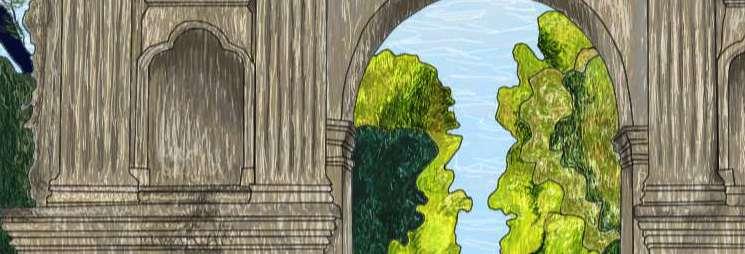
 SA PANULAT NI: JULIENNE RAMANO
WRITTEN
ILLUSTRATED BY : Cris Jefferson Juan ILLUSTRATED BY : Krynica Rhyzz Lozada
ILLUSTRATED BY : Krynica Rhyzz Lozada and Maozu Maramag
SA PANULAT NI: JULIENNE RAMANO
WRITTEN
ILLUSTRATED BY : Cris Jefferson Juan ILLUSTRATED BY : Krynica Rhyzz Lozada
ILLUSTRATED BY : Krynica Rhyzz Lozada and Maozu Maramag



“I accept this role. I pledge myself to Apollo, God of Oracles. I open my eyes to the future and embrace the past. I accept the spirit of Delphi, Voice of the Gods, Speaker of Riddles, Seer of Fate.



Tick Tock Tick Tock Tick Tock. Alas kwatro na ng hapon!


Ramdam na ang ihip ng sariwang hangin sa aking mga balat– Oras na ito
upang kunin ang ginawang saranggola ng aking mga
kaibigan kahapon at dalhin ito sa palayan.
Inihagis namin ang saranggola upang lumipad at nagsimula
nang makipaglaban sa paghila ang aking kamay at braso sa tali ng pulang saranggola.
Makaraan ang dalawampung
minuto, bigla kong naramdaman ang pagputol ng tali ng aming saranggola.
Pinagmasdan
namin ang paghulog ng saranggola mula sa ulap na nagpinta ng kalungkutan sa aming mga mukha.
Ngunit dito sa probinsya, hindi kami tumitigil maglaro hangga’t hindi lumulubog and haring araw. Maraming pang pwede gawin gaya ng pagpitas ng mangga sa mga puno, paghuli ng mga gagamba sa palayan, paliligo sa bukid, pakikipaglaro sa mga aso at paghahabulan naming mga kaibigan sa malawak na lupain.
Ayan ang mga ala-ala ko noong nasa probinsya pa ako. Ang saya pero simple, hindi ba? Kung papipiliin lang din ako, hindi na ako aalis sa probinsya. Ikaw, gusto mo bang magpalipad ng saranggola?
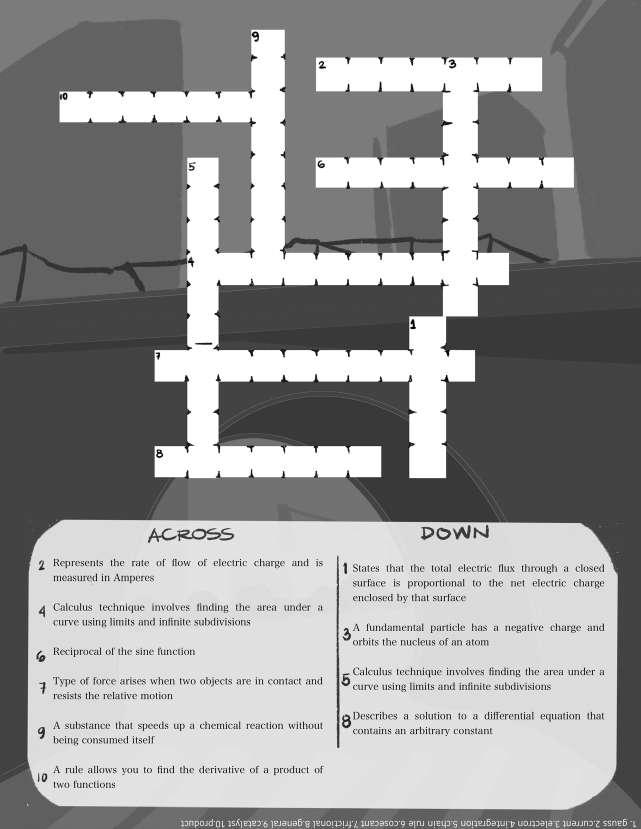

Noon, sa asim-kilig na kanta at awiting kay ligaya, sa patalastas ng aming telebisyon ay nakita. Isang nakakatuwang bata ang maganang kumakain ng lutong sinigang ng kanyang ina. Sa sabaw pa lamang ay ulam na, anong higit pa kaya ang sustansyang dulot kung ito’y sisinupin pa?
Aba! Walang katumbas ang lutong bahay ng ating mga ina! Ang Sinigang ni Mama ng puno ng pagmamahal at pag-aaruga, sa pagod, pighati, pait at anghang ng buhay, siyang nagpapakalma at nagpapaginhawa.

 -Rachel Elizabeth Dare, Percy Jackson and The Olympians: The Last Olympian
ILLUSTRATED BY : Waldy De Castro
ILLUSTRATED BY : Cris Jefferson Juan
-Rachel Elizabeth Dare, Percy Jackson and The Olympians: The Last Olympian
ILLUSTRATED BY : Waldy De Castro
ILLUSTRATED BY : Cris Jefferson Juan
The Department of Science and Technology (DOST) launched a plant-based wastewater treatment facility using ‘phyto vortex’ technology last April 2023 to enhance water quality in Subic Water and Sewerage Co., Inc. (SUBICWATER) at Zambales.
The project is entitled “Constructed Wetland for Wastewater Treatment of Effluent from a Water Provider,” and according to DOST Undersecretary Dr. Leah Buendia, it utilizes indigenous Filipino plants such as canna lily, vetiver grass, and phragmites vulgaris.
According to DOST, SUBICWATER needed to diminish water pollutants in their wastewater treatment facility to fully comply with the Water Quality Guidelines and General Effluent Standards of 2016 (DAO 2016-08).
Due to this, the project was implemented to lessen the concentration of such pollutants using a reed bed sewage system, which is used to simulate natural wetlands for wastewater treatment and is based on phytoremediation.
The project also utilized soil matrix selection to enable the best
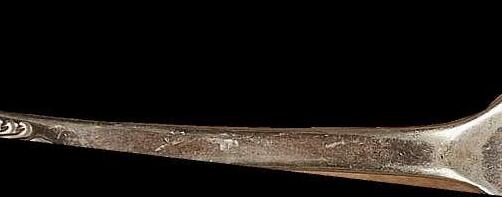
enable aeration which reduces pollutant gases.
Phyto vortex technology, then, is the combination of phytoreme diation technology, vortex technology, and removal of FOG to eliminate primary and secondary effluents through plants and reed beds. The said technology is a first in the Philippines, so TIP aims for its large-scale application in the country.
The cutting-edge project paved the way for this integration of in novative technologies by taking advantage of plants as well as vortex technology, which is being used in India. Multiple design upgrades were then performed to ensure the effectiveness of the phyto vortex technology in treating wastewater.
Who Wins in this Game-Changing Technology?
Some of those that would benefit from this endeavor include industries, especially those lined up in waterways. TIP Manila VP for Academic Affairs Dr. Rosalinda Valdepeñas said the technology would provide a healthy balance between environmental preservation and private industry support.
Other beneficiaries include wastewater treatment facilities in the country, which may use the technology to abide better by the DAO 2016-
used and it could be adapted easily in other areas of the country.
Although, there have been numerous failed attempts at using plants for wastewater treatment, especially as it affects plant survival and does not completely prevent groundwater contamination. Nevertheless, Antonio emphasized that they aim to look back at those failures and seek a feasible alternative through the project.
The project is also low-risk and low-maintenance as the constructed wetlands would allow for absorbing and transforming contaminants into harmless substances through sunlight, microorganisms, and soil layers.
As for the technology used, phytoremediation is widely accepted and is potentially the least harmful method based on its characteristics, but it is limited to plants’ root zone and would take longer than standard bioremediation. There are also very few studies on vortex technology and its effects on reducing pollutants, so further research is needed
Still, the combination of vortex technology with phytoremediation holds immense potential in wastewater treatment once it succeeds, according to experts.

B12, and other micronutrients. Therefore, dieters continue to favor tra ditional meat.
The price of cultured meat and its market value should also be factored in. According to a study in the Journal of Agriculture and Food Research, cultured meat produced on a large scale would cost around $63 per kg (around PHP 3482.00) to create if done so using inexpensive and effective methods. Practically speaking, a kilogram would cost more than $100 (or PHP 5527.00) at stores and dining establishments.
meat produced entirely in a laboratory. Making this involves extracting stem cells from an animal (e.g. cow, chicken, or fish) and placing them in a bioreactor with vitamins and amino acids that act as the animal’s body’s replacement in order to develop muscle fibers that resemble ground beef. Since it doesn’t involve animal slaughter, cultured meat strives to be a cruelty-free alternative. However, instead of mimicking its appearance like plant-based meat, it seeks to become a viable replacement for it. Nonetheless, cultured meat is not regarded as a vegan or vegetarian option.
Cultured beef uses less water and land resources hence, it is more environmentally friendly. Theoretically, 10 cells can create 50,000 metric tonnes of meat. As compared to conventional beef, lab-grown meat has a less ecological footprint if renewable energy sources are used and it does not emit as much methane as actual cows.
lab-grown meat producers are currently attempting to switch from FBS to artificial serum so that cultured meat will be a truly cruelty-free product.

According to a 2019 study by John Lynch and Raymond Pierrehumbert, researchers from the University of Oxford Department of Physics, manufacturing cultured meat, however, primarily depends on high energy production using fossil fuels that may produce larger concentrations of carbon dioxide. As carbon dioxide builds and disintegrates more slowly than methane does, cultured meat might have negative long-term repercussions.
Additionally, cultured meat is devoid of the bloodstream, which restricts the delivery of nutrients and oxygen, which potentially reduces the meat’s nutritional value. Meat produced in laboratories lacks essential significant nutrients necessary for optimal health like iron, vitamin
In the agricultural aspect, the need for livestock farmers might become irrelevant once this innovation popularizes. One thing to be considered is that cattle offer more than just meat; they are an important source of items that are used in a variety of industries (e.g. soap-making beef fat, leather, insulin).
Although cultured meat has several benefits, the key issue that needs to be considered is consumer acceptance. Customers may always choose traditional meat over cultured meat since the latter still falls short in terms of color, texture, and flavor. This invention is still the subject of research, particularly regarding its large-scale manufacturing. When more information becomes available, future cost projections, health effects, and environmental implications can be estimated with greater accuracy. For the time being, it is still unclear if lab-grown meat represents a risk to the industry or will be the future of meat.
Scientists from the Massachusetts Institute of Technology (MIT) and University of Maryland (UMD) demonstrated permanent but reversible adhesion of “soft materials” through the use of an electric current in a new study which could have promising applications in the field of medical treatments for healing incisions after surgical procedures.

The phenomenon in use, known as “electroadhesion,” has been extensively studied for decades for its applications in clothing, industry, robotics, and just recently—medical procedures.
In the study published by the American Chemical Society (ACS), researchers have shown that through electroadhesion, scientists could make two soft gels made from polymers derived from living organisms stick together by running a 10V current through the materials for around 10 seconds allowing them to gain the ability to stick to each other permanently.
In addition to being a strong bond able to overcome the force of gravity, substances adhered through electroadhesion can be separated from each other by simply reversing the polarity of the currents running through the material, making electroadhesion both controllable and reversible.
This finding comes a few years after the same researchers conducted experiments on adhering gels to animal tissue through electroadhesion with the goal of achieving “suture-less repair of cuts and tears.”
The science behind electroadhesion. Electroadhesion is described by Persson (2021) as “an attractive force that occurs between two contacting materials when there is an electrical potential difference between them” and is a phenomenon that has been observed as early as 1917 in metal parts of early telephones.
This is made possible by electrostatic attraction between opposite charges that creates an attraction force that could overcome gravity and other forces.



The phenomenon has been studied for industrial applications such as robotics where electroadhesion has been used for the creation of “wall-climbing robots” and manufacturing where it has been used to create electroadhesive transport chains to facilitate the transport of output in a production line.

Potential for use in surgery. The main advantage of using electroadhesion for medical treatment in place of traditional stitches comes from the innate reversibility of the adhesion and how this property allows for greater room for error in a high-stakes situation such as surgery.
In the experiments involving binding animal tissue from 2021, scientists have applied electroadhesion to bovine aorta tissue and discovered that gel and tissue fused through electroadhesion withstood up to five times more stress applied in comparison to mere contact adhesion.
The same study also found that “compared to current surgical ad-
hesives, an electroadhered gel patch provides a very robust and durable seal that persists indefinitely” which opens opportunities for its wider adoption in biomedical fields.
Issues with electroadhesion. Despite advancements and discoveries on the useful properties of electroadhesion, it is not a technique that is ready for use in surgical procedures involving humans in the present because much still needs to be understood about the principles of electroadhesion in human tissue.
For once, electroadhesion has only been observed to work with certain types of animal tissue (such as the aorta, cornea, and lungs) and fail to adhere in others (heart, brain, fat tissue, etc.) making its use still limited.
The gels used in electroadhesion also face similar problems as materials used for threads in traditional medical sutures with the gels needing to be biodegradable and without triggering adverse reactions in the patient’s body (mainly the immune system).
Still, studies on the potential of electroadhesion in the field of biomedical treatments contribute greatly to the progress of advancing the overall state of medical treatment and further research on this topic will only push us toward achieving milestones in this field.
Wrapping up the year 2022 outstandingly and beginning the year 2023 excellently with a win, this is how the Filipino Olympian and the world’s top 3 pole vaulter, Ernest John “EJ” Obiena, continued his flourishing career, showcasing once again his excellence and sheer determination at every incredible height he reaches and leaps into.
Beginning his year 2023 was his competition in the Internationales Springer-Meeting held in Cottbus, Germany, last January 26, where he bagged a silver medal finish after clearing 5.77 meters. Ahead of him is United States’ two-time champion, Sam Kendricks, who dominated the 10-man event after successfully acing 5.82 meters. Belgium’s Ben Broeders then settled for the bronze medal with 5.72 meters.
Obiena tried to replace Kendrick’s record, but at the 5.82-meter height, he faltered midair in his two tries, and in the final attempt, he unexpectedly hit the bar on his way down.

Having reinforced his vigor, just three days after his previous event, the Filipino pole vaulter competed in the Perche en Or indoor tournament in Roubaix, France, where he earned his first gold for the year. Obiena surpassed China’s Yao Jie record after successfully clearing the 5.82-meter height on his first attempt. Gold medalist Obiena attempted to surpass greater heights but fell short in clearing 5.9.
Meanwhile, the competition’s silver medalist Yao recorded his new personal best after reaching 5.75 meters. Meanwhile, home country bet Ethan Cormont settled for a bronze medal via countback after having a tie with his two fellow rookies.
In the same week, February 2, Obiena participated at the prestigious Mondo Classic in Uppsala, Sweden. The Filipino pole vault star cleared his best height of 5.91 meters, which he first achieved last year in the Perche Elite Tour in France. With his 5.91 thirdtry clearance, he finished a spot behind home bet and world record holder Mondo Duplantis and United States’ KC Lightfoot via countback.
With Obiena’s winning spree, he didn’t snap as he leaped through 5.77 meters and ruled the 11-player field of the Orlen Cup in Poland last February 4. United States’ Sam Kendricks captured silver, while hometown bet Piotr Lisek secured bronze via countback.
“It was a difficult physically 27-year-old media.

However, these series of competitions resulted in Obiena’s non-participation in the Asian Indoor Athletics Championship, which was scheduled on February 10-12. He cited two major reasons behind his pullout which are logistics and financial constraints. Nevertheless, he still continued his training for the next competitions.
“Who could work for free for over a year? They have families to support and bills to pay. They can’t keep working for free,” said Obiena in a lengthy social media post about his decision to skip the said competition.
“I can only hope this resolves soon. I am losing a team I desperately need. Nobody wins alone. It’s always been a team effort, he added.”
Hours after Obiena’s social media post, Philippine Sports Commission chairman Richard Bachmann said he “immediately communicated with him and took internal actions.”
“I also received communication on this matter from the Philippine Athletics Track and Field Association (PATAFA) and will continue to speed things up to help their national sports association and Mr. Obiena,” Bachmann added. “We continue to give our elite athletes the best support we can.”
With the mentioned issue, Obiena’s next tournament was the 10-man Orlen Copernicus Cup in Torun, Poland, on February 8. Maintaining his impressive momentum from his previous competition, Obiena claimed his back-to-back gold medal, soaring past 5.87 meters in two tries. He also topped the same tournament last year.
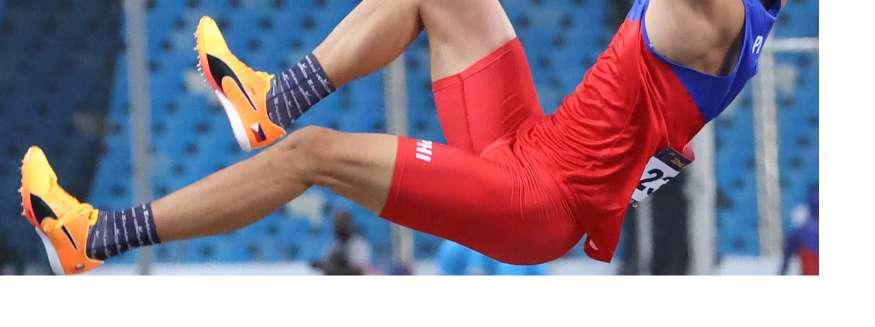
After securing gold, Obiena tried to dethrone the long-standing Asian indoor record of 5.92 meters set by Kazakhstan’s Igor Potapovich in 1998 but his attempt was unsuccessful.
Meanwhile, Rutger Koppelaar of the Netherlands and Ben Broeders of Belgium finished silver and bronze, respectively, via countback.


The University of Santo Tomas (UST) Golden Tigresses put up a good fight in the recently concluded University Athletic Association of the Philippines (UAAP) Season 85 Women’s Volleyball Tournament. Eya Laure, the tournament’s leading scorer during the previous season, led the black and gold squad to the final four, ending the season in fourth place.
Seniors of the team, Milena Alessandrini and Imee Hernandez, stepped up as the Golden Tigresses went against the likes of the season 84 defending champions, the National University (NU) Lady Bulldogs, and the powerhouse De La Salle (DLSU) Lady Spikers.
The first match of the Golden Tigresses was a 5-set nail-biter against the DLSU Lady Spikers. The game ended with the runners-up from last season defeating the España squad with a fifth-set score of 16-14. Despite losing their first game, the Golden Tigresses still proved that they are still one of the contenders for Season 85, after they dominated the Far Eastern University (FEU) Lady Tamaraws in their next game with a set score of 3-0.
The main highlight of the first round of the tourney was the upset made by the Golden Tigresses when they snapped the Season 84 champions, NU Lady Bulldogs’ 20-game winning streak, which started two seasons ago. The Lady Bulldogs almost made a comeback after catching up to the two-set lead of the Golden Tigresses, forcing a five-setter game. Laure led the squad with 18 points on 14 hits and four blocks.
As said by the Queen Tigress during her interview with inquirer.net, “It cannot be accomplished by relying on just one player. We must work as a team.” This chemistry proved to be effective as the Golden Tigresses ended the first round of the tourney with a standing of 5-2, only losing to the undefeated DLSU Lady Spikers and the host, Adamson (AdU) Lady Falcons.
The second round of the Golden Tigresses also started with a loss against the AdU Lady Falcons, but still retained their compo-
sure and won most of their games. They even tainted the record of the league-leading DLSU Lady Spikers by giving them their first loss in the season, three sets to one. This prevented the sweep of the DLSU Lady Spikers and brought back the traditional format for the final four. Alessandrini and Laure led the squad with scores of 29 and 20, respectively. Cassie Carballo’s 18 excellent sets and Bernadett Pepito’s 25 digs also aided the Golden Tigresses to secure their spot in the final four, improving their record to 7-3.
The Golden Tigresses went on and finished the second round in the fourth spot with a standing of 10-4, in which their fourth loss was given by the NU Lady Bulldogs. This standing earned them a ticket to the final four wherein they faced the season’s leading squad, DLSU Lady Spikers in the final four. The Taft squad had a twice-to-beat advantage. The Golden Tigresses again fell short of entering the finals after losing against the Lady Spikers in a four-set match, 3-1.
Even though they failed to reach the finals, the Golden Tigresses still have a lot of takeaways. Laure ended her collegiate career as a leading scorer for back-to-back seasons, and Bernadett Pepito went on to win the Best Libero award, which showed her potential for contributing to the upcoming seasons for the team.
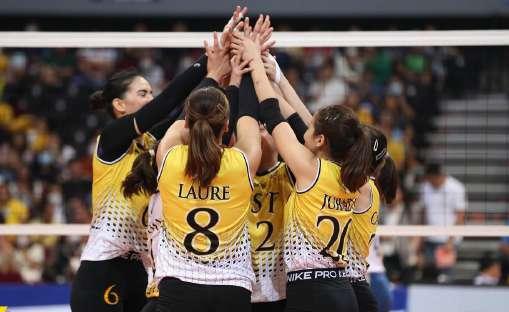
In contrast to this, losses in the team was also experienced, as Laure and Hernandez forwent their remaining playing years as Thomasians and opted to go pro and play in the Premier Volleyball League (PVL). Alessandrini will also leave the university after graduating, which leaves Pepito, Carballo, and Jurado to serve as the frontrunners for the squad next season.
These gains and losses will surely affect the España squad in a lot of ways come UAAP Season 86. But one thing is for sure: the unending support of the Thomasian community will surely be present in their games and on their path to hopefully obtain another final-four spot and maybe emerge as champions for the next season.
Obiena didn’t fail to again tally a win in his record as he took home a silver medal in the Internationales Stadionfest (ISTAF) Indoor Berlin held in Berlin, Germany, last February 11. Clearing 5.82 meters in a single try, he prevailed over bronze medalist Kurtis Marschall of Australia, who equaled the height but had two tries. Meanwhile, Olympic gold medalist Armand Duplantis topped the competition for three straight years with his 6.06 clearance.
However, EJ Obiena’s streak of glorious victories broke when he placed last in Meeting Hauts-de-France Pas-de-Calais in the Arena Stade Couvert, Liévin in France, on February 16. He hurdled 5.64 meters, which was numerous meters away from the winning 6.01 meters of Armand Duplantis. Claudio Michel Stecchi of Italy grabbed the silver medal via countback, while Kurtis Marschall and Jacob Wooten were tied for the bronze medal.
Months later, Obiena returned strong and bounced back for the Southeast Asian Games held at Phnom Penh, Cambodia, on May 8. The Filipino pole vaulter icon brought home the gold medal three times already in 2023. Despite the rainy situation, he erased his record of 5.46 meters set last year in Vietnam and replaced it with 5.65 meters. Kasinpob Chomchanad and Patsapong Amsamaring of Thailand clinched second and third place, respectively.




The Filipino pride welcomed the month of June with a bag of pride and honors in the Sparebanken Vest Bergen Jump Challenge held at Bryggen, Norway, on Saturday, June 10. Starting off with him acing a height of 6 meters, adding gold to his record. The gold-winning height let Obiena enter the exclusive 6-meter club. Trailing his lead is KC Lightfoot of the United States, who also reached 6 meters, but with two tries. Sam Kendricks of the USA clinched the bronze with 5.88 meters.
The Electronics Engineering student’s electrifying performance and incredible skills are truly inspiring for his fellow Filipino athletes. His journey is a testimony that obstacles and setbacks will always be there. These challenges will leave an indelible mark of lessons and determination that can be used as fuel to rise and strive for excellence.